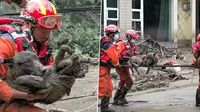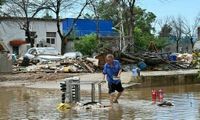In the remote stretches of Inner Mongolia’s grasslands, what was meant to be a tranquil night under the stars turned into a harrowing ordeal as a flash flood tore through a wild camping site, leaving devastation in its wake. On the night of August 17, 2025, at around 10 p.m. local time, the banks of a river near Urad Rear Banner in Bayannur City burst, unleashing a torrent of water that swept away a group of 13 campers on the outskirts of this major agricultural hub. By the following morning, the scale of the tragedy had become heartbreakingly clear: ten people were confirmed dead, two remained missing, and only one camper had been rescued alive, according to multiple reports from Xinhua and Global Times.
More than 700 rescuers, including firefighters and emergency personnel, were swiftly dispatched to the scene, combing the rugged landscape for any sign of the missing. Drones hovered above the muddy riverbanks, while teams on foot and in boats scoured the floodplain in a race against time. Local emergency authorities described the search as “urgent,” and the Ministry of Emergency Management ordered full-scale rescue efforts, dispatching a working group to coordinate the operation on the ground (as reported by Xinhua and CCTV).
The campers, who were enjoying the wild beauty of Urad Rear Banner—a region known for its expansive grasslands and mountainous terrain—were caught off guard by the sudden surge. The floodwaters struck with little warning, washing away tents, vehicles, and any hopes for a peaceful night. By Sunday morning, eight bodies had been recovered, with two more found later that day, bringing the confirmed death toll to ten. The search for the remaining two missing individuals continued into Sunday evening, with rescue teams refusing to give up hope (as detailed in reports by Associated Press and Dawn).
This tragedy comes amid a period of extreme weather that has battered China since July. The East Asian monsoon, typically a seasonal lifeline for agriculture, has instead brought heavier-than-usual downpours and unpredictable flooding to both northern and southern parts of the country. Scientists and weather experts have linked these shifting patterns to climate change, warning that human-driven warming is making destructive floods more frequent and intense. According to Dawn, this year’s monsoon has “unleashed atmospheric chaos across the world’s second-largest economy.”
Bayannur, the city at the heart of this disaster, is not just a scenic destination for campers—it is a linchpin in China’s food security. The area is a major grain and oil production base, as well as a center for sheep breeding and processing. Floods here, therefore, threaten not only lives but also livelihoods, with the potential to disrupt the region’s agricultural output and ripple through the national economy.
As the rescue operation unfolded in Inner Mongolia, other parts of China were grappling with the fallout of similar disasters. In the southwestern province of Sichuan, severe weather on August 15 killed two people and injured three others at a beer festival in Mianzhu, after a truss collapsed amid heavy rain, according to local police reports cited by Dawn and AP. Meanwhile, in the southern province of Hainan, a three-and-a-half-month fishing suspension—imposed due to persistent, heavy rain—finally ended on August 16, with officials ordering ships to shelter in port until the worst had passed.
Perhaps most sobering is that the Urad Rear Banner tragedy is not an isolated event. Northern China has seen a string of deadly floods and landslides in recent weeks. In early August, flash floods and mudslides in Gansu province left at least 13 dead and dozens missing. Late last month, a catastrophic downpour in Beijing, less than 1,000 kilometers away, killed at least 44 people and forced the evacuation of more than 70,000 residents from the city’s rural suburbs. Even Hong Kong was not spared, experiencing historic deluges that left parts of the city underwater.
The Chinese central government has responded to this onslaught of disasters by ramping up relief funding. In early August, it announced an additional 430 million yuan (about $59.9 million) in disaster relief, bringing the total allocated since April to at least 5.8 billion yuan. These funds are aimed at supporting rescue operations, rebuilding infrastructure, and helping displaced residents get back on their feet. But as the frequency and intensity of such events increase, the pressure on local and national authorities to adapt and prepare is mounting.
“Natural disasters are common across China, particularly in the summer, when some regions experience heavy rain while others bake in searing heat,” noted Dawn. This year, however, the scale and persistence of the extreme weather have tested officials and emergency responders like never before. The Ministry of Emergency Management has not only coordinated rescue efforts in Inner Mongolia but also ordered a verification of the status of the missing and dispatched specialized teams to support local authorities (as reported by CCTV).
For the families of those lost in the Urad Rear Banner flood, the outpouring of support from the community and the relentless efforts of rescuers offer some solace, but the pain of loss remains raw. The tragedy has reignited calls for better early warning systems, improved campsite safety protocols, and greater public awareness of the risks posed by camping near rivers during the rainy season. Many are now asking: could this have been prevented, or is it simply the new reality in an era of climate uncertainty?
As China’s summer of storms continues, the nation finds itself grappling with the human and economic costs of a changing climate. The story of the campers swept away in Inner Mongolia is a stark reminder of nature’s power—and the urgent need for resilience in the face of ever-more unpredictable weather. For now, the rescue teams keep searching, and a nation watches, hoping for miracles amid the mud and debris.


